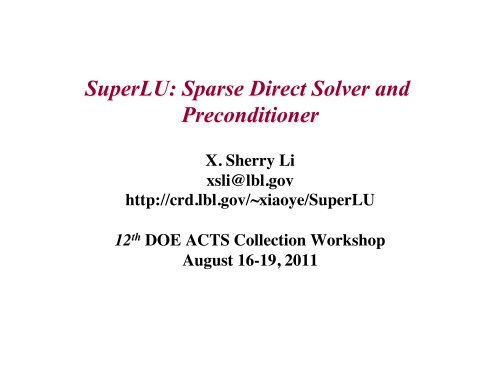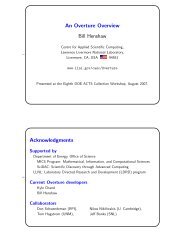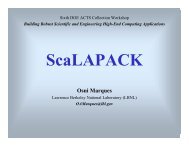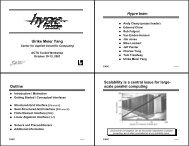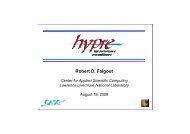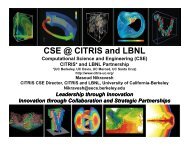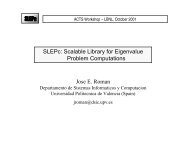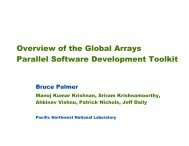SuperLU: Sparse Direct Solver and Preconditioner
SuperLU: Sparse Direct Solver and Preconditioner
SuperLU: Sparse Direct Solver and Preconditioner
Create successful ePaper yourself
Turn your PDF publications into a flip-book with our unique Google optimized e-Paper software.
<strong>SuperLU</strong>: <strong>Sparse</strong> <strong>Direct</strong> <strong>Solver</strong> <strong>and</strong><br />
<strong>Preconditioner</strong><br />
X. Sherry Li<br />
xsli@lbl.gov<br />
http://crd.lbl.gov/~xiaoye/<strong>SuperLU</strong><br />
12 th DOE ACTS Collection Workshop<br />
August 16-19, 2011
Acknowledgements<br />
§� Supports from DOE, NSF, DARPA<br />
§� TOPS (Towards Optimal Petascale Simulations)<br />
§� CEMM (Center for Extended MHD Modeling)<br />
§� Developers <strong>and</strong> contributors<br />
§� Sherry Li, LBNL<br />
§� James Demmel, UC Berkeley<br />
§� John Gilbert, UC Santa Barbara<br />
§� Laura Grigori, INRIA, France<br />
§� Meiyue Shao, Umeå University, Sweden<br />
§� Pietro Cicotti, UC San Diego<br />
§� Daniel Schreiber, UIUC<br />
§� Yu Wang, U. North Carolina, Charlotte<br />
§� Ichitaro Yamazaki, LBNL<br />
§� Eric Zhang, Albany High<br />
<strong>SuperLU</strong> tutorial<br />
2
Quick installation<br />
§� Download site http://crd.lbl.gov/~xiaoye/<strong>SuperLU</strong><br />
§� Users’ Guide, HTML code documentation<br />
§� Gunzip, untar<br />
§� Follow README at top level directory<br />
§� Edit make.inc for your platform (compilers, optimizations, libraries, ...)<br />
<strong>SuperLU</strong> tutorial<br />
(may move to autoconf in the future)<br />
§� Link with a fast BLAS library<br />
• The one under CBLAS/ is functional, but not optimized<br />
• Vendor, GotoBLAS, ATLAS, …<br />
3
Outline of Tutorial<br />
§� Functionality<br />
§� Background of the algorithms<br />
§� Differences between sequential <strong>and</strong> parallel solvers<br />
§� <strong>Sparse</strong> matrix data structure, distribution, <strong>and</strong> user interface<br />
§� Examples, Fortran 90 interface<br />
<strong>SuperLU</strong> tutorial<br />
4
<strong>Sparse</strong> linear solvers<br />
§� Solving a system of linear equations Ax = b<br />
• <strong>Sparse</strong>: many zeros in A; worth special treatment<br />
§� Iterative methods<br />
§� A is not changed (read-only)<br />
§� Key kernel: sparse matrix-vector multiply<br />
• Easier to optimize <strong>and</strong> parallelize<br />
§� Low algorithmic complexity, but may not converge<br />
§� <strong>Direct</strong> methods<br />
§� A is modified (factorized)<br />
• Harder to optimize <strong>and</strong> parallelize<br />
§� Numerically robust, but higher algorithmic complexity<br />
§� Often use direct method to precondition iterative method<br />
<strong>SuperLU</strong> tutorial<br />
5
Available direct solvers<br />
§� Survey of different types of factorization codes<br />
http://crd.lbl.gov/~xiaoye/<strong>SuperLU</strong>/<strong>Sparse</strong><strong>Direct</strong>Survey.pdf<br />
§� LL T (s.p.d.)<br />
§� LDL T (symmetric indefinite)<br />
§� LU (nonsymmetric)<br />
§� QR (least squares)<br />
§� Sequential, shared-memory (multicore), distributed-memory, out-ofcore<br />
§� GPU, FPGA become active, no public code yet.<br />
§� Distributed-memory codes: usually MPI-based<br />
§� <strong>SuperLU</strong>_DIST [Li/Demmel/Grigori/Yamazaki]<br />
<strong>SuperLU</strong> tutorial<br />
• accessible from PETSc, Trilinos, . . .<br />
§� MUMPS, PasTiX, WSMP, . . .<br />
6
<strong>SuperLU</strong> Functionality<br />
§� LU decomposition, triangular solution<br />
§� Incomplete LU (ILU) preconditioner (serial <strong>SuperLU</strong> 4.0 up)<br />
§� Transposed system, multiple RHS<br />
§� Sparsity-preserving ordering<br />
§� Minimum degree ordering applied to A T A or A T +A [MMD, Liu `85]<br />
§� ‘Nested-dissection’ applied to A T A or A T +A [(Par)Metis, (PT)-Scotch]<br />
§� User-controllable pivoting<br />
§� Pre-assigned row <strong>and</strong>/or column permutations<br />
§� Partial pivoting with threshold<br />
§� Equilibration: D<br />
§� Condition number estimation<br />
§� Iterative refinement<br />
§� Componentwise error bounds [Skeel `79, Arioli/Demmel/Duff `89]<br />
<strong>SuperLU</strong> tutorial<br />
r c AD<br />
7
Software Status<br />
<strong>SuperLU</strong> tutorial<br />
<strong>SuperLU</strong> <strong>SuperLU</strong>_MT <strong>SuperLU</strong>_DIST<br />
Platform Serial SMP, multicore Distributed<br />
Language C C + Pthreads<br />
Data type Real/complex,<br />
Single/double<br />
or OpenMP<br />
Real/complex,<br />
Single/double<br />
memory<br />
C + MPI<br />
Real/complex,<br />
Double<br />
§� Fortran interfaces<br />
§� <strong>SuperLU</strong>_MT similar to <strong>SuperLU</strong> both numerically <strong>and</strong> in usage<br />
8
Adoptions of <strong>SuperLU</strong><br />
§� Industry<br />
§� Cray Scientific Libraries<br />
§� FEMLAB<br />
§� HP Mathematical Library<br />
§� IMSL Numerical Library<br />
§� NAG<br />
§� Sun Performance Library<br />
§� Python (NumPy, SciPy)<br />
§� Research<br />
§� In ACTS Tools: Hypre, PETSc, Overture, Trilinos<br />
§� M3D-C 1 , NIMROD (burning plasmas for fusion energys)<br />
§� Omega3P (accelerator design)<br />
§� . . .<br />
<strong>SuperLU</strong> tutorial<br />
9
Review of Gaussian Elimination (GE)<br />
§� Solving a system of linear equations Ax = b<br />
§� First step of GE: (make sure not too small . . . Otherwise do pivoting)<br />
⎡⎡α<br />
A = ⎢⎢<br />
⎣⎣v<br />
§� Repeats GE on C<br />
§� Results in {L\U} decomposition (A = LU)<br />
§� L lower triangular with unit diagonal, U upper triangular<br />
§� Then, x is obtained by solving two triangular systems with L <strong>and</strong> U<br />
<strong>SuperLU</strong> tutorial<br />
w<br />
T<br />
B<br />
⎤⎤<br />
⎥⎥<br />
⎦⎦<br />
=<br />
α<br />
⎡⎡ 1 0⎤⎤<br />
⎡⎡α<br />
⎢⎢ ⎥⎥ ⋅ ⎢⎢<br />
⎣⎣v<br />
/ α I ⎦⎦ ⎣⎣0<br />
w<br />
T<br />
C<br />
C<br />
⎤⎤<br />
⎥⎥<br />
⎦⎦<br />
=<br />
v ⋅ w<br />
B −<br />
α<br />
T<br />
10
<strong>Sparse</strong> GE – fill-in<br />
§� Scalar algorithm: 3 nested loops<br />
• Can re-arrange loops to get different variants: left-looking, rightlooking,<br />
. . .<br />
1<br />
L<br />
2<br />
<strong>SuperLU</strong> tutorial<br />
3<br />
4<br />
U<br />
5<br />
6<br />
7<br />
for i = 1 to n<br />
column_scale ( A(:,i) )<br />
for k = i+1 to n s.t. A(i,k) != 0<br />
for j = i+1 to n s.t. A(j,i) != 0<br />
A(j,k) = A(j,k) - A(j,i) * A(i,k)<br />
Typical fill-ratio: 10x for 2D problems, 30-50x for 3D problems<br />
11
Data structure: Compressed Row Storage (CRS)<br />
§� Store nonzeros row by row contiguously<br />
§� Example: N = 7, NNZ = 19<br />
§� 3 arrays:<br />
§� Storage: NNZ reals, NNZ+N+1 integers<br />
<strong>SuperLU</strong> tutorial<br />
1 3 5 8 11 13 17 20<br />
nzval 1 a 2 b c d 3 e 4 f 5 g h i 6 j k l 7<br />
colind 1 4 2 5 1 2 3 2 4 5 5 7 4 5 6 7 3 5 7<br />
rowptr 1 3 5 8 11 13 17 20<br />
Many other data structures: “Templates for the Solution of Linear Systems:<br />
Building Blocks for Iterative Methods”, R. Barrett et al.<br />
⎛⎛1<br />
⎜⎜<br />
⎜⎜<br />
⎜⎜c<br />
⎜⎜<br />
⎜⎜<br />
⎜⎜<br />
⎜⎜<br />
⎜⎜<br />
⎜⎜<br />
⎝⎝<br />
2<br />
d<br />
e<br />
3<br />
k<br />
a<br />
4<br />
h<br />
b<br />
f<br />
5<br />
i<br />
l<br />
6<br />
12<br />
⎞⎞<br />
⎟⎟<br />
⎟⎟<br />
⎟⎟<br />
⎟⎟<br />
⎟⎟<br />
g ⎟⎟<br />
⎟⎟<br />
j ⎟⎟<br />
7<br />
⎟⎟<br />
⎠⎠
General <strong>Sparse</strong> <strong>Solver</strong><br />
§� Use (blocked) CRS or CCS, <strong>and</strong> any ordering method<br />
§� Leave room for fill-ins ! (symbolic factorization)<br />
§� Exploit “supernode” (dense) structures in the factors<br />
§� Can use Level 3 BLAS<br />
§� Reduce inefficient indirect addressing (scatter/gather)<br />
§� Reduce graph traversal time using a coarser graph<br />
<strong>SuperLU</strong> tutorial<br />
13
Overview of the Algorithms<br />
§� <strong>Sparse</strong> LU factorization: P r A P c T = L U<br />
§� Choose permutations P r <strong>and</strong> P c for numerical stability, minimizing fillin,<br />
<strong>and</strong> maximizing parallelism.<br />
§� Phases for sparse direct solvers<br />
1. Order equations & variables to minimize fill-in.<br />
<strong>SuperLU</strong> tutorial<br />
§� NP-hard, so use heuristics based on combinatorics.<br />
2. Symbolic factorization.<br />
§� Identify supernodes, set up data structures <strong>and</strong> allocate memory for L & U.<br />
3. Numerical factorization – usually dominates total time.<br />
§� How to pivot?<br />
4. Triangular solutions – usually less than 5% total time.<br />
14
Numerical Pivoting<br />
§� Goal of pivoting is to control element growth in L & U for stability<br />
§� For sparse factorizations, often relax the pivoting rule to trade with better<br />
sparsity <strong>and</strong> parallelism (e.g., threshold pivoting, static pivoting , . . .)<br />
§� Partial pivoting used in sequential <strong>SuperLU</strong> <strong>and</strong> <strong>SuperLU</strong>_MT (GEPP)<br />
§� Can force diagonal pivoting (controlled by diagonal<br />
threshold)<br />
§� Hard to implement scalably for sparse factorization<br />
§� Static pivoting used in <strong>SuperLU</strong>_DIST (GESP)<br />
§� Before factor, scale <strong>and</strong> permute A to maximize diagonal: P r D r A D c = A’<br />
§� During factor A’ = LU, replace tiny pivots by ε A , without changing data<br />
structures for L & U<br />
§� If needed, use a few steps of iterative refinement after the first solution<br />
è� quite stable in practice<br />
<strong>SuperLU</strong> tutorial<br />
s x x<br />
x<br />
b<br />
x x x<br />
15
Ordering : Minimum Degree<br />
Local greedy: minimize upper bound on fill-in<br />
1 ⎡⎡x<br />
i j k l<br />
x x x x⎤⎤<br />
⎡⎡x<br />
1<br />
i j k l<br />
x x x<br />
i<br />
j<br />
k<br />
l<br />
⎢⎢<br />
⎢⎢<br />
⎢⎢x<br />
⎢⎢<br />
⎢⎢<br />
⎢⎢x<br />
⎢⎢<br />
⎢⎢<br />
⎢⎢x<br />
⎢⎢<br />
⎢⎢<br />
⎢⎢⎣⎣<br />
x<br />
<strong>SuperLU</strong> tutorial<br />
1<br />
l<br />
i<br />
k<br />
j<br />
⎥⎥<br />
⎥⎥<br />
⎥⎥<br />
⎥⎥<br />
⎥⎥<br />
⎥⎥<br />
⎥⎥<br />
⎥⎥<br />
⎥⎥<br />
⎥⎥<br />
⎥⎥<br />
⎥⎥⎦⎦<br />
Eliminate 1<br />
Eliminate 1<br />
i<br />
j<br />
k<br />
l<br />
i<br />
l<br />
⎢⎢<br />
⎢⎢<br />
⎢⎢x<br />
⎢⎢<br />
⎢⎢<br />
⎢⎢x<br />
⎢⎢<br />
⎢⎢<br />
⎢⎢x<br />
⎢⎢<br />
⎢⎢<br />
⎢⎢⎣⎣<br />
x<br />
•<br />
•<br />
•<br />
•<br />
j<br />
k<br />
•<br />
•<br />
•<br />
•<br />
•<br />
•<br />
•<br />
•<br />
x⎤⎤<br />
⎥⎥<br />
⎥⎥<br />
•⎥⎥<br />
⎥⎥<br />
⎥⎥<br />
•⎥⎥<br />
⎥⎥<br />
⎥⎥<br />
•⎥⎥<br />
⎥⎥<br />
⎥⎥<br />
•⎥⎥⎦⎦<br />
16
Ordering : Nested Dissection<br />
§� Model problem: discretized system Ax = b from certain PDEs,<br />
e.g., 5-point stencil on n x n grid, N = n 2<br />
§� Factorization flops: O( n 3 ) = O( N 3/2 )<br />
§� Theorem: ND ordering gives optimal complexity in exact<br />
arithmetic [George ’73, Hoffman/Martin/Rose]<br />
<strong>SuperLU</strong> tutorial<br />
17
ND Ordering<br />
§� Generalized nested dissection [Lipton/Rose/Tarjan ’79]<br />
§� Global graph partitioning: top-down, divide-<strong>and</strong>-conqure<br />
§� Best for largest problems<br />
§� Parallel codes available: ParMetis, Scotch<br />
§� First level<br />
§� Recurse on A <strong>and</strong> B<br />
§� Goal: find the smallest possible separator S at each level<br />
§� Multilevel schemes:<br />
<strong>SuperLU</strong> tutorial<br />
A S B<br />
⎡⎡A<br />
⎢⎢<br />
⎢⎢<br />
0<br />
⎢⎢⎣⎣<br />
x<br />
x⎤⎤<br />
x<br />
⎥⎥<br />
⎥⎥<br />
S⎥⎥⎦⎦<br />
• Chaco [Hendrickson/Lel<strong>and</strong> `94], Metis [Karypis/Kumar `95]<br />
§� Spectral bisection [Simon et al. `90-`95]<br />
§� Geometric <strong>and</strong> spectral bisection [Chan/Gilbert/Teng `94]<br />
0<br />
B<br />
x<br />
18
ND Ordering<br />
<strong>SuperLU</strong> tutorial<br />
2D mesh A, with row-wise ordering<br />
A, with ND ordering L &U factors<br />
19
Ordering for LU (unsymmetric)<br />
§� Can use a symmetric ordering on a symmetrized matrix<br />
• Case of partial pivoting (serial <strong>SuperLU</strong>, <strong>SuperLU</strong>_MT):<br />
Use ordering based on A T *A<br />
• Case of static pivoting (<strong>SuperLU</strong>_DIST):<br />
Use ordering based on A T +A<br />
§� Can find better ordering based solely on A, without<br />
symmetrization<br />
• Diagonal Markowitz [Amestoy/Li/Ng `06]<br />
• Similar to minimum degree, but without symmetrization<br />
• Hypergraph partition [Boman, Grigori, et al. `08]<br />
• Similar to ND on A T A, but no need to compute A T A<br />
<strong>SuperLU</strong> tutorial<br />
20
Ordering Interface in <strong>SuperLU</strong><br />
§� Library contains the following routines:<br />
§� Ordering algorithms: MMD [J. Liu], COLAMD [T. Davis]<br />
§� Utility routines: form A T +A , A T A<br />
§� Users may input any other permutation vector (e.g., using<br />
Metis, Chaco, etc. )<br />
<strong>SuperLU</strong> tutorial<br />
. . .<br />
set_default_options_dist ( &options );<br />
options.ColPerm = MY_PERMC; // modify default option<br />
ScalePermstructInit ( m, n, &ScalePermstruct );<br />
METIS ( . . . , &ScalePermstruct.perm_c );<br />
. . .<br />
pdgssvx ( &options, . . . , &ScalePermstruct, . . . );<br />
. . .<br />
21
Symbolic Factorization<br />
§� Cholesky [George/Liu `81 book]<br />
§� Use elimination graph of L <strong>and</strong> its transitive reduction (elimination tree)<br />
§� Complexity linear in output: O(nnz(L))<br />
§� LU<br />
§� Use elimination graphs of L & U <strong>and</strong> their transitive reductions<br />
(elimination DAGs) [Tarjan/Rose `78, Gilbert/Liu `93, Gilbert `94]<br />
§� Improved by symmetric structure pruning [Eisenstat/Liu `92]<br />
§� Improved by supernodes<br />
§� Complexity greater than nnz(L+U), but much smaller than flops(LU)<br />
<strong>SuperLU</strong> tutorial<br />
22
Numerical Factorization<br />
§� Sequential <strong>SuperLU</strong><br />
§� Enhance data reuse in memory hierarchy by calling Level 3 BLAS on<br />
the supernodes<br />
§� <strong>SuperLU</strong>_MT<br />
§� Exploit both coarse <strong>and</strong> fine grain parallelism<br />
§� Employ dynamic scheduling to minimize parallel runtime<br />
§� <strong>SuperLU</strong>_DIST<br />
§� Enhance scalability by static pivoting <strong>and</strong> 2D matrix distribution<br />
<strong>SuperLU</strong> tutorial<br />
23
<strong>SuperLU</strong>_MT [Li/Demmel/Gilbert]<br />
§� Pthread or OpenMP<br />
§� Left-looking – relatively more READs than WRITEs<br />
§� Use shared task queue to schedule ready columns in the<br />
elimination tree (bottom up)<br />
§� Over 12x speedup on conventional 16-CPU SMPs (1999)<br />
<strong>SuperLU</strong> tutorial<br />
L<br />
U<br />
DONE<br />
P 1 P 2<br />
A<br />
WORKING NOT<br />
TOUCHED<br />
P2<br />
P1<br />
DONE WORKING<br />
24
<strong>SuperLU</strong>_DIST [Li/Demmel/Grigori/Yamazaki]<br />
§� MPI<br />
§� Right-looking – relatively more WRITEs than READs<br />
§� 2D block cyclic layout<br />
§� Look-ahead to overlap comm. & comp.<br />
§� Scales to 1000s processors<br />
<strong>SuperLU</strong> tutorial<br />
0 1 2 0 1 2<br />
3 4<br />
0 1<br />
3 4<br />
0 1<br />
3 4<br />
0<br />
1<br />
5<br />
2<br />
5<br />
2<br />
5<br />
2<br />
ACTIVE<br />
Matrix<br />
3 4<br />
0 1<br />
3 4<br />
0 1<br />
3 4<br />
0<br />
1<br />
5<br />
2<br />
5<br />
2<br />
5<br />
2<br />
0<br />
3<br />
0<br />
3<br />
0<br />
3<br />
0<br />
Process mesh<br />
0 1 2<br />
3 4<br />
5<br />
25
Multicore platforms<br />
v� Intel Clovertown:<br />
� 2.33 GHz Xeon, 9.3 Gflops/core<br />
� 2 sockets x 4 cores/socket<br />
� L2 cache: 4 MB/2 cores<br />
v� Sun VictoriaFalls:<br />
� 1.4 GHz UltraSparc T2, 1.4 Gflops/core<br />
� 2 sockets x 8 cores/socket x 8 hardware threads/core<br />
� L2 cache shared: 4 MB<br />
<strong>SuperLU</strong> tutorial<br />
26
Benchmark matrices<br />
g7jac200 Economic<br />
model<br />
stomach 3D finite<br />
diff.<br />
torso3 3D finite<br />
diff.<br />
twotone Nonlinear<br />
analog<br />
circuit<br />
<strong>SuperLU</strong> tutorial<br />
apps dim nnz(A) SLU_MT<br />
Fill<br />
SLU_DIST<br />
Fill<br />
59,310 0.7 M 33.7 M 33.7 M 1.9<br />
213,360 3.0 M 136.8 M 137.4 M 4.0<br />
259,156 4.4 M 784.7 M 785.0 M 3.1<br />
120,750 1.2 M 11.4 M 11.4 M 2.3<br />
Avg.<br />
S-node<br />
27
Intel Clovertown<br />
v� Maximum speedup 4.3, smaller than conventional SMP<br />
v� Pthreads scale better<br />
v� Question: tools to analyze resource contention?<br />
<strong>SuperLU</strong> tutorial<br />
28
SunVictoriaFalls – multicore + multithread<br />
<strong>SuperLU</strong> tutorial<br />
<strong>SuperLU</strong>_MT <strong>SuperLU</strong>_DIST<br />
§� Maximum speedup 20<br />
§� Pthreads more robust, scale better<br />
§� MPICH crashes with large #tasks,<br />
mismatch between coarse <strong>and</strong><br />
fine grain models<br />
29
User interface – distribute input matrices<br />
§� Matrices involved:<br />
§� A, B (turned into X) – input, users manipulate them<br />
<strong>SuperLU</strong> tutorial<br />
§� L, U – output, users do not need to see them<br />
§� A (sparse) <strong>and</strong> B (dense) are distributed by block rows<br />
P0<br />
P1<br />
P2<br />
x x x x<br />
x x x<br />
x x x<br />
A<br />
x x x<br />
B<br />
Local A stored in<br />
Compressed Row Format<br />
§� Natural for users, <strong>and</strong> consistent with other popular packages: e.g.<br />
PETSc<br />
30
Distributed input interface<br />
§� Each process has a structure to store local part of A<br />
Distributed Compressed Row Storage<br />
typedef struct {<br />
<strong>SuperLU</strong> tutorial<br />
int_t nnz_loc; // number of nonzeros in the local submatrix<br />
int_t m_loc; // number of rows local to this processor<br />
int_t fst_row; // global index of the first row<br />
void *nzval; // pointer to array of nonzero values, packed by row<br />
int_t *colind; // pointer to array of column indices of the nonzeros<br />
int_t *rowptr; // pointer to array of beginning of rows in nzval[]<strong>and</strong> colind[]<br />
} NRformat_loc;<br />
31
Distributed Compressed Row Storage<br />
A is distributed on 2 processors:<br />
§� Processor P0 data structure:<br />
§� nnz_loc = 5<br />
§� m_loc = 2<br />
§� fst_row = 0 // 0-based indexing<br />
§� nzval = { s, u, u, l, u }<br />
§� colind = { 0, 2, 3, 0, 1 }<br />
§� rowptr = { 0, 3, 5 }<br />
<strong>SuperLU</strong> tutorial<br />
P0<br />
P1<br />
s u u<br />
l u<br />
l p<br />
e u<br />
l l r<br />
§� Processor P1 data structure:<br />
§� nnz_loc = 7<br />
§� m_loc = 3<br />
§� fst_row = 2 // 0-based indexing<br />
§� nzval = { l, p, e, u, l, l, r }<br />
§� colind = { 1, 2, 3, 4, 0, 1, 4 }<br />
§� rowptr = { 0, 2, 4, 7 }<br />
32
Process grid <strong>and</strong> MPI communicator<br />
§� Example: Solving a preconditioned linear system<br />
M -1 A x = M -1 b<br />
<strong>SuperLU</strong> tutorial<br />
M = diag(A 11 , A 22 , A 33 )<br />
� use <strong>SuperLU</strong>_DIST for<br />
each diagonal block<br />
A11 0 1<br />
2 3<br />
§� Create 3 process grids, same logical ranks (0:3),<br />
but different physical ranks<br />
§� Each grid has its own MPI communicator<br />
4 5<br />
A22<br />
6 7<br />
8 9<br />
A33<br />
10 11<br />
33
Two ways to create a process grid<br />
§� superlu_gridinit( MPI_Comm Bcomm, int nprow,<br />
int npcol, gridinfo_t *grid );<br />
§� Maps the first {nprow, npcol} processes in the MPI communicator<br />
Bcomm to <strong>SuperLU</strong> 2D grid<br />
§� superlu_gridmap( MPI_Comm Bcomm, int nprow,<br />
int npcol, int usermap[], int ldumap, gridinfo_t *grid );<br />
§� Maps an arbitrary set of {nprow, npcol } processes in the MPI<br />
communicator Bcomm to <strong>SuperLU</strong> 2D grid. The ranks of the selected<br />
MPI processes are given in usermap[] array.<br />
For example:<br />
<strong>SuperLU</strong> tutorial<br />
0<br />
1<br />
0 1 2<br />
11 12 13<br />
14 15 16<br />
34
Performance of larger matrices<br />
Name Application Data<br />
type<br />
matrix211 Fusion,<br />
MHD eqns<br />
cc_linear2<br />
v� Sparsity ordering: MeTis applied to structure of A’+A<br />
<strong>SuperLU</strong> tutorial<br />
(M3D-C1)<br />
Fusion,<br />
MHD eqns<br />
(NIMROD)<br />
matick Circuit sim.<br />
MNA method<br />
(IBM)<br />
cage13 DNA<br />
electrophoresis<br />
N |A| / N<br />
Sparsity<br />
|L\U|<br />
(10^6)<br />
Real 801,378 161 1276.0 9.9<br />
Complex 259,203 109 199.7 7.1<br />
Complex 16,019 4005 64.3 1.0<br />
Fill-ratio<br />
Real 445,315 17 4550.9 608.5<br />
35
Strong scaling (fixed size): Cray XE6 (hopper@nersc)<br />
§� #5 on the Top500 Supercomputer list<br />
§� 2 x 12-core AMD 'MagnyCours’ per node, 2.1 GHz processor<br />
v� Up to 1.4 Tflops factorization rate<br />
<strong>SuperLU</strong> tutorial<br />
36
ILU Interface<br />
§� Available in serial <strong>SuperLU</strong> 4.0, June 2009<br />
§� Similar to ILUTP [Saad]: “T” = threshold, “P” = pivoting<br />
§� among the most sophisticated, more robust than structurebased<br />
dropping (e.g., level-of-fill)<br />
§� ILU driver: SRC/dgsisx.c<br />
ILU factorization routine: SRC/dgsitrf.c<br />
GMRES driver: EXAMPLE/ditersol.c<br />
§� Parameters:<br />
§� ilu_set_default_options ( &options )<br />
<strong>SuperLU</strong> tutorial<br />
• options.ILU_DropTol – numerical threshold ( τ )<br />
• options.ILU_FillFactor – bound on the fill-ratio ( γ )<br />
37
Result of Supernodal ILU (S-ILU)<br />
§� New dropping rules S-ILU(τ, γ)<br />
<strong>SuperLU</strong> tutorial<br />
§� supernode-based thresholding (τ )<br />
§� adaptive strategy to meet user-desired<br />
fill-ratio upper bound ( γ )<br />
§� Performance of S-ILU<br />
§� For 232 test matrices, S-ILU + GMRES converges with 138<br />
cases (~60% success rate)<br />
§� S-ILU + GMRES is 1.6x faster than scalar ILU + GMRES<br />
i
S-ILU for extended MHD (fusion energy)<br />
§� AMD Opteron 2.4 GHz (Cray XT5)<br />
§� ILU parameters: τ = 10 -4 , Υ = 10<br />
§� Up to 9x smaller fill ratio, <strong>and</strong> 10x faster<br />
Problems order Nonzeros<br />
(millions)<br />
<strong>SuperLU</strong> tutorial<br />
<strong>SuperLU</strong><br />
Time fill-ratio<br />
S-ILU<br />
time fill-ratio<br />
GMRES<br />
Time Iters<br />
matrix31 17,298 2.7 m 33.3 13.1 8.2 2.7 0.6 9<br />
matrix41 30,258 4.7 m 111.1 17.5 18.6 2.9 1.4 11<br />
matrix61 66,978 10.6 m 612.5 26.3 54.3 3.0 7.3 20<br />
matrix121 263,538 42.5 m x x 145.2 1.7 47.8 45<br />
matrix181 589,698 95.2 m x x 415.0 1.7 716.0 289
Tips for Debugging Performance<br />
§� Check sparsity ordering<br />
§� Diagonal pivoting is preferable<br />
§� E.g., matrix is diagonally dominant, . . .<br />
§� Need good BLAS library (vendor, ATLAS, GOTO, . . .)<br />
§� May need adjust block size for each architecture<br />
<strong>SuperLU</strong> tutorial<br />
( Parameters modifiable in routine sp_ienv() )<br />
• Larger blocks better for uniprocessor<br />
• Smaller blocks better for parallellism <strong>and</strong> load balance<br />
§� Open problem: automatic tuning for block size?<br />
40
Exercise of <strong>SuperLU</strong>_DIST<br />
§� http://crd.lbl.gov/~xiaoye/<strong>SuperLU</strong>/slu_h<strong>and</strong>s_on.html<br />
<strong>SuperLU</strong> tutorial<br />
41
Examples in EXAMPLE/<br />
§� pddrive.c: Solve one linear system<br />
§� pddrive1.c: Solve the systems with same A but different righth<strong>and</strong><br />
side at different times<br />
§� Reuse the factored form of A<br />
§� pddrive2.c: Solve the systems with the same pattern as A<br />
§� Reuse the sparsity ordering<br />
§� pddrive3.c: Solve the systems with the same sparsity pattern<br />
<strong>and</strong> similar values<br />
§� Reuse the sparsity ordering <strong>and</strong> symbolic factorization<br />
§� pddrive4.c: Divide the processes into two subgroups (two<br />
grids) such that each subgroup solves a linear system<br />
independently from the other.<br />
<strong>SuperLU</strong> tutorial<br />
42
<strong>SuperLU</strong>_DIST Example Program<br />
§� <strong>SuperLU</strong>_DIST_2.5/EXAMPLE/pddrive.c<br />
§� Five basic steps<br />
1. Initialize the MPI environment <strong>and</strong> <strong>SuperLU</strong> process grid<br />
2. Set up the input matrices A <strong>and</strong> B<br />
3. Set the options argument (can modify the default)<br />
4. Call <strong>SuperLU</strong> routine PDGSSVX<br />
5. Release the process grid, deallocate memory, <strong>and</strong> terminate the MPI<br />
environment<br />
<strong>SuperLU</strong> tutorial<br />
43
EXAMPLE/pddrive.c<br />
#include "superlu_ddefs.h“<br />
main(int argc, char *argv[])<br />
{<br />
superlu_options_t options;<br />
<strong>SuperLU</strong>Stat_t stat;<br />
SuperMatrix A;<br />
ScalePermstruct_t ScalePermstruct;<br />
LUstruct_t LUstruct;<br />
SOLVEstruct_t SOLVEstruct;<br />
gridinfo_t grid;<br />
· · · · · ·<br />
/* Initialize MPI environment */<br />
MPI_Init( &argc, &argv );<br />
· · · · · ·<br />
/* Initialize the <strong>SuperLU</strong> process grid */<br />
nprow = npcol = 2;<br />
superlu_gridinit(MPI_COMM_WORLD,<br />
nprow, npcol, &grid);<br />
<strong>SuperLU</strong> tutorial<br />
/* Read matrix A from file, distribute it, <strong>and</strong> set up<br />
the right-h<strong>and</strong> side */<br />
dcreate_matrix(&A, nrhs, &b, &ldb, &xtrue,<br />
&ldx, fp, &grid);<br />
/* Set the options for the solver. Defaults are:<br />
options.Fact = DOFACT;<br />
options.Equil = YES;<br />
options.ColPerm = MMD_AT_PLUS_A;<br />
options.RowPerm = LargeDiag;<br />
options.ReplaceTinyPivot = YES;<br />
options.Trans = NOTRANS;<br />
options.IterRefine = DOUBLE;<br />
options.SolveInitialized = NO;<br />
options.RefineInitialized = NO;<br />
options.PrintStat = YES;<br />
*/<br />
set_default_options_dist(&options);<br />
44
EXAMPLE/pddrive.c (cont.)<br />
/* Initialize ScalePermstruct <strong>and</strong> LUstruct. */<br />
ScalePermstructInit (m, n,<br />
&ScalePermstruct);<br />
LUstructInit (m, n, &LUstruct);<br />
/* Initialize the statistics variables. */<br />
PStatInit(&stat);<br />
/* Call the linear equation solver. */<br />
pdgssvx (&options, &A, &ScalePermstruct,<br />
b, ldb, nrhs, &grid, &LUstruct,<br />
&SOLVEstruct, berr, &stat, &info );<br />
/* Print the statistics. */<br />
PStatPrint (&options, &stat, &grid);<br />
/* Deallocate storage */<br />
PStatFree (&stat);<br />
Destroy_LU (n, &grid, &LUstruct);<br />
LUstructFree (&LUstruct);<br />
<strong>SuperLU</strong> tutorial<br />
}<br />
/* Release <strong>SuperLU</strong> process grid */<br />
superlu_gridexit (&grid);<br />
/* Terminate MPI execution environment */<br />
MPI_Finalize ();<br />
45
Fortran 90 Interface<br />
§� <strong>SuperLU</strong>_DIST_2.5/FORTRAN/<br />
§� All <strong>SuperLU</strong> objects (e.g., LU structure) are opaque for F90<br />
§� They are allocated, deallocated <strong>and</strong> operated in the C side <strong>and</strong> not<br />
directly accessible from Fortran side.<br />
§� C objects are accessed via h<strong>and</strong>les that exist in Fortran’s user<br />
space<br />
§� In Fortran, all h<strong>and</strong>les are of type INTEGER<br />
§� Example:<br />
<strong>SuperLU</strong> tutorial<br />
⎡⎡s<br />
u u ⎤⎤<br />
⎢⎢<br />
l u<br />
⎥⎥<br />
⎢⎢<br />
⎥⎥<br />
A<br />
= ⎢⎢ l p ⎥⎥ , s = 19.<br />
0,<br />
u = 21.<br />
0,<br />
p = 16.<br />
0,<br />
e = 5.<br />
0,<br />
r = 18.<br />
0,<br />
l =<br />
⎢⎢<br />
⎥⎥<br />
⎢⎢<br />
e u<br />
⎥⎥<br />
⎢⎢⎣⎣<br />
l l r⎥⎥⎦⎦<br />
12.<br />
0<br />
46
<strong>SuperLU</strong>_DIST_2.5/FORTRAN/f_5x5.f90<br />
program f_5x5<br />
use superlu_mod<br />
include 'mpif.h'<br />
implicit none<br />
integer maxn, maxnz, maxnrhs<br />
parameter ( maxn = 10, maxnz = 100,<br />
maxnrhs = 10 )<br />
integer colind(maxnz), rowptr(maxn+1)<br />
real*8 nzval(maxnz), b(maxn),<br />
berr(maxnrhs)<br />
integer n, m, nnz, nrhs, ldb, i, ierr, info, iam<br />
integer nprow, npcol<br />
integer init<br />
integer nnz_loc, m_loc, fst_row<br />
real*8 s, u, p, e, r, l<br />
integer(superlu_ptr) :: grid<br />
integer(superlu_ptr) :: options<br />
integer(superlu_ptr) :: ScalePermstruct<br />
integer(superlu_ptr) :: LUstruct<br />
integer(superlu_ptr) :: SOLVEstruct<br />
integer(superlu_ptr) :: A<br />
integer(superlu_ptr) :: stat<br />
<strong>SuperLU</strong> tutorial<br />
! Initialize MPI environment<br />
call mpi_init(ierr)<br />
! Create Fortran h<strong>and</strong>les for the C structures used<br />
! in <strong>SuperLU</strong>_DIST<br />
call f_create_gridinfo(grid)<br />
call f_create_options(options)<br />
call f_create_ScalePermstruct(ScalePermstruct )<br />
call f_create_LUstruct(LUstruct)<br />
call f_create_SOLVEstruct(SOLVEstruct)<br />
call f_create_SuperMatrix(A)<br />
call f_create_<strong>SuperLU</strong>Stat(stat)<br />
! Initialize the <strong>SuperLU</strong>_DIST process grid<br />
nprow = 1<br />
npcol = 2<br />
call f_superlu_gridinit<br />
(MPI_COMM_WORLD,<br />
nprow, npcol, grid)<br />
call get_GridInfo(grid, iam=iam)<br />
47
f_5x5.f90 (cont.)<br />
! Set up the input matrix A<br />
! It is set up to use 2 processors:<br />
! processor 1 contains the first 2 rows<br />
! processor 2 contains the last 3 rows<br />
m = 5<br />
n = 5<br />
nnz = 12<br />
s = 19.0<br />
u = 21.0<br />
p = 16.0<br />
e = 5.0<br />
r = 18.0<br />
l = 12.0<br />
if ( iam == 0 ) then<br />
nnz_loc = 5<br />
m_loc = 2<br />
fst_row = 0 ! 0-based indexing<br />
nzval (1) = s<br />
colind (1) = 0 ! 0-based indexing<br />
nzval (2) = u<br />
colind (2) = 2<br />
nzval (3) = u<br />
colind (3) = 3<br />
nzval (4) = l<br />
colind (4) = 0<br />
nzval (5) = u<br />
colind (5) = 1<br />
rowptr (1) = 0 ! 0-based indexing<br />
rowptr (2) = 3<br />
rowptr (3) = 5<br />
<strong>SuperLU</strong> tutorial<br />
else nnz_loc = 7<br />
m_loc = 3<br />
fst_row = 2 ! 0-based indexing<br />
nzval (1) = l<br />
colind (1) = 1<br />
nzval (2) = p<br />
colind (2) = 2<br />
nzval (3) = e<br />
colind (3) = 3<br />
nzval (4) = u<br />
colind (4) = 4<br />
nzval (5) = l<br />
colind (5) = 0<br />
nzval (6) = l<br />
colind (6) = 1<br />
nzval (7) = r<br />
colind (7) = 4<br />
rowptr (1) = 0 ! 0-based indexing<br />
rowptr (2) = 2<br />
rowptr (3) = 4<br />
rowptr (4) = 7<br />
endif<br />
48
f_5x5.f90 (cont.)<br />
! Create the distributed compressed row<br />
! matrix pointed to by the F90 h<strong>and</strong>le<br />
call f_dCreate_CompRowLoc_Matrix_dist<br />
(A, m, n, nnz_loc, m_loc, fst_row, &<br />
nzval, colind, rowptr, LU_NR_loc, &<br />
SLU_D, SLU_GE)<br />
! Setup the right h<strong>and</strong> side<br />
nrhs = 1<br />
call get_CompRowLoc_Matrix<br />
(A, nrow_loc=ldb)<br />
do i = 1, ldb<br />
b(i) = 1.0<br />
enddo<br />
! Set the default input options<br />
call f_set_default_options(options)<br />
! Modify one or more options<br />
Call set_superlu_options<br />
(options,ColPerm=NATURAL)<br />
call set_superlu_options<br />
(options,RowPerm=NOROWPERM)<br />
<strong>SuperLU</strong> tutorial<br />
! Initialize ScalePermstruct <strong>and</strong> LUstruct<br />
call get_SuperMatrix (A,nrow=m,ncol=n)<br />
call f_ScalePermstructInit(m, n,<br />
ScalePermstruct)<br />
call f_LUstructInit(m, n, LUstruct)<br />
! Initialize the statistics variables<br />
call f_PStatInit(stat)<br />
! Call the linear equation solver<br />
call f_pdgssvx(options, A, ScalePermstruct, b,<br />
ldb, nrhs, grid, LUstruct, SOLVEstruct,<br />
berr, stat, info)<br />
! Deallocate the storage allocated by <strong>SuperLU</strong>_DIST<br />
call f_PStatFree(stat)<br />
call f_Destroy_SuperMatrix_Store_dist(A)<br />
call f_ScalePermstructFree(ScalePermstruct)<br />
call f_Destroy_LU(n, grid, LUstruct)<br />
call f_LUstructFree(LUstruct)<br />
49
f_5x5.f90 (cont.)<br />
! Release the <strong>SuperLU</strong> process grid<br />
call f_superlu_gridexit(grid)<br />
! Deallocate the C structures pointed to by the<br />
! Fortran h<strong>and</strong>les<br />
call f_destroy_gridinfo(grid)<br />
call f_destroy_options(options)<br />
Call f_destroy_ScalePermstruct(ScalePermstruct)<br />
call f_destroy_LUstruct(LUstruct)<br />
call f_destroy_SOLVEstruct(SOLVEstruct)<br />
call f_destroy_SuperMatrix(A)<br />
call f_destroy_<strong>SuperLU</strong>Stat(stat)<br />
! Terminate the MPI execution environment<br />
call mpi_finalize(ierr)<br />
Stop<br />
end<br />
<strong>SuperLU</strong> tutorial<br />
50
Summary<br />
§� <strong>Sparse</strong> LU, ILU are important kernels for science <strong>and</strong> engineering<br />
applications, used in practice on a regular basis<br />
§� Performance more sensitive to latency than dense case<br />
§� Continuing developments funded by DOE SciDAC projects<br />
§� Integrate into more applications<br />
§� Hybrid model of parallelism for multicore/vector nodes, differentiate<br />
intra-node <strong>and</strong> inter-node parallelism<br />
<strong>SuperLU</strong> tutorial<br />
§� Hybrid programming models, hybrid algorithms<br />
§� Parallel HSS precondtioners<br />
§� Parallel hybrid direct-iterative solver based on domain decomposition<br />
51


